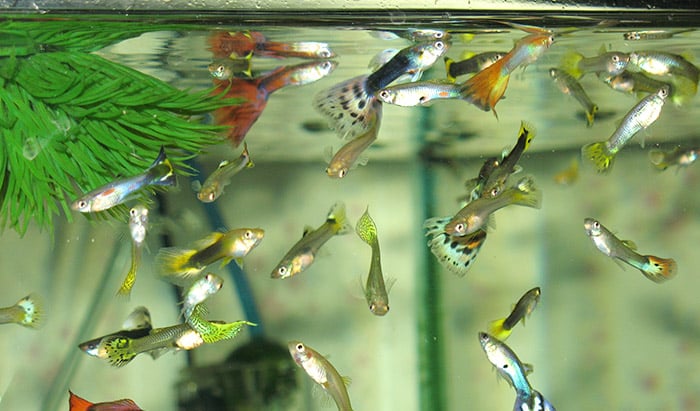What is Guppy Fish?
Guppies are one of the most popular freshwater fish in the world. They’re also referred to as million fish and rainbow fish.
Guppies originated in South America but are now distributed worldwide. In the wild, they prefer slow-moving streams and ponds with lots of vegetation.
Male guppies have brighter colors and longer tails than females. Guppies are livebearers, which means they give birth to live babies rather than laying eggs.
Guppies are popular freshwater aquarium fish among both novice and experienced hobbyists. They are quite simple to care for, and their vibrant colors and active personalities make them a welcome addition to any tank. These beautiful little fish are reasonably priced, and they reproduce well in captivity.
Guppies are very popular in community tanks due to their compatibility with other peaceful fish.
Furthermore, Guppies are gregarious creatures that thrive in groups. A group of at least six guppies is recommended. If you keep them with other fish, ensure the tank is large enough for everyone and that the other fish are not hostile.
Types of Guppy Fish
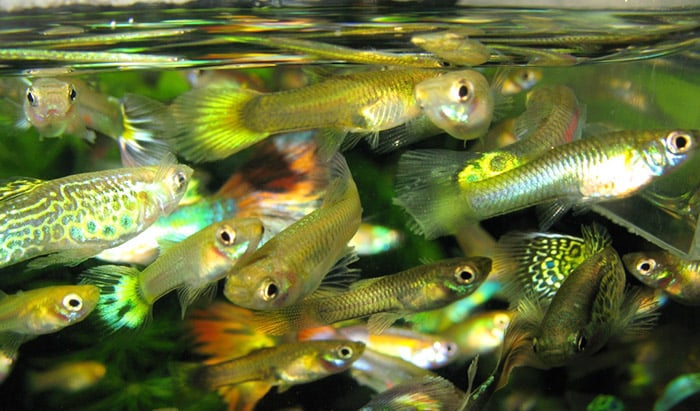
There are a variety of different types of guppy fish that you can choose from. Each type has its unique features and colors. Color, pattern, and fin type are three distinguishing characteristics of most Guppy Fish.
Fancy Guppy
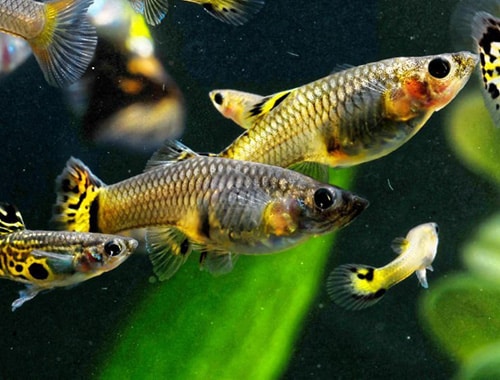
Fancy Guppies are the largest type of guppy, reaching a maximum size of about 3.5 inches. As their name suggests, they are considered the most “fancy” or “ornamental” of all the guppy varieties.
They originate from North America and come in a wide range of colors and patterns, including bi-colored, tri-colored, and even quads (four colors). Notably, they are also available in various colors, including blue, red, orange, yellow, green, purple, and pink.
The Fancy Guppy is by far the most popular type of guppy fish. They are easily recognizable with their brightly colored bodies and long, flowing fins.
Endler’s Guppy

Endler’s Guppies are some of the smallest guppies, reaching a maximum size of only about 1.5 inches.
They are named after John Endler, who first described them in 1975. These guppies are native to Venezuela and can be found in various colors, including blue, green, red, orange, yellow, and brown.
They have very distinct black markings on their bodies that make them easily recognizable.
Tiger Guppies
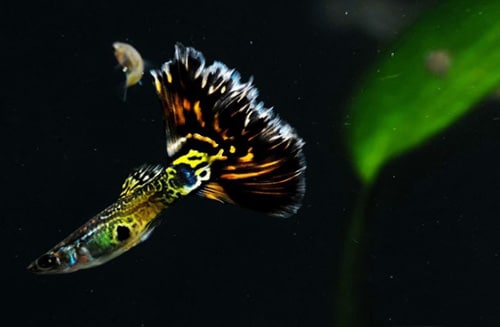
Tiger Guppies are slightly larger than Endler’s Guppies, as an adult Tiger Guppy can be 2.5-inch length, making them suitable for medium-sized fish tanks.
Many might not know that they get their name from the dark vertical stripes that run down their bodies, which resemble those of a tiger.
These guppies are native to Trinidad and Tobago and come in vibrant colors, including blue, green, yellow, orange, and red.
Albino Guppies
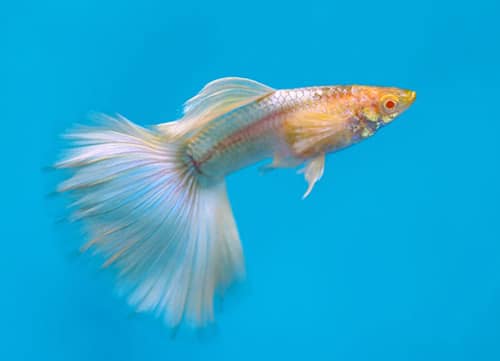
Albino Guppies are a breathtakingly beautiful species of guppy. Their lack of pigment in their bodies gives them a whitish or pale look, but they have brilliant red-orange tails and even crimson eyes.
As a result, they are incredibly light-sensitive and should be kept in an aquarium with low lighting. Also, these fish are less resilient than other types of guppy fish and require more care.
Because of their distinct appearance, Albino Guppies are quite popular among aquarium hobbyists. Actually, female Albino Guppies are very costly due to their rareness.
Guppy Fish appearance
Here’s some facts about the notable appearance of most Guppies:
Guppies come in a variety of colors, including red, blue, yellow, green, purple, platinum, black, and more. Many of them are a fusion of two to three colors, making them a magical fish species with a beautiful appearance.
They range in size from 2 to 4 inches (5 to 10 cm).
They are known for their brightly colored bodies and long fins. Their fins are also open wide and are mostly solid-colored.
Many Guppies feature leopard, Grass, glass, Mosaic, and even lace patterns.
The tail fin of a male guppy is usually much longer and more elaborate than a female’s.
Guppies are born with brown or olive-colored bodies, but as they mature, they develop their characteristic bright colors.
Guppies can also have spots or stripes on their bodies. Some guppies have patterns that resemble eyes on their tails, which are thought to help deter predators.
Guppy Fish behavior
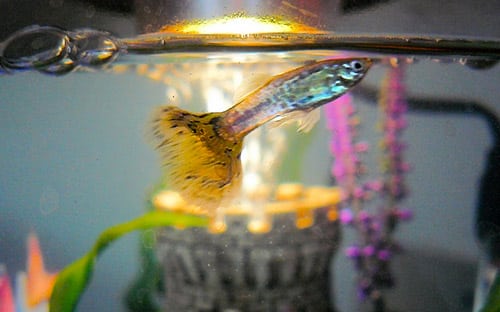
Guppies are sociable creatures who thrive when kept in groups. They should be kept alongside other peaceful fish of similar size. Guppies are not hostile, but they can be nippy, so keep them away from delicate or slow-moving fish.
Guppies are infamous for being prolific breeders, therefore aquarium owners who keep these fish must be prepared to deal with this. If an owner does not want their guppies to reproduce, the fry (young fish) should be removed from the aquarium as soon as they are born.
It is advisable to retain no more than one male guppy for every three or four females, as males can be rather aggressive toward females if kept in too high a ratio.
Guppies are not picky eaters and will consume almost any sort of aquarium fish food. They should be fed a range of foods to ensure that they obtain all of the nutrients they require.
Guppies are also known to be tough fish that can survive in a variety of water conditions.
Male vs Female guppy fish
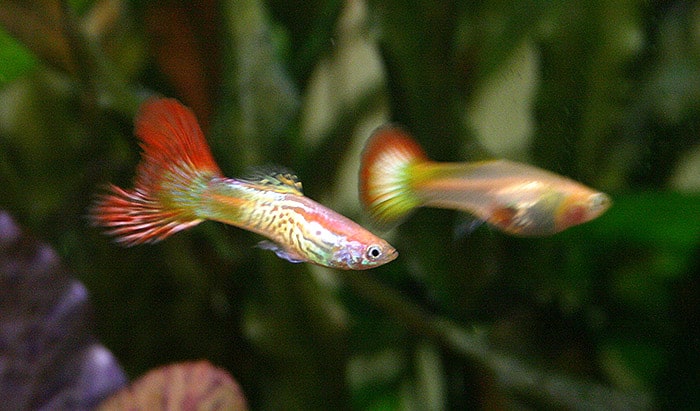
When it comes to guppy fish, there are some key differences between males and females.
Appearance
Male guppies are much more colorful than females. Their bodies are decorated with bright hues and patterns that stand out in a crowd, while female guppies tend to be duller in coloration.
Size
Male guppies are typically smaller than females. The average male guppy is about one-third to one-half the size of the average female.
Fins
Male guppies have longer fins than females. This is especially noticeable in their tail fins, which can flow gracefully behind them as they swim.
Life Span
Females usually live a bit longer than males, often by several months. However, in captivity, both genders typically have a lifespan of two to three years.
Behavior
Males are typically more active and outgoing than females. Male guppies are much more active than females and are constantly on the move. They also tend to be a little more aggressive, especially when it comes to competing for mates.
Female guppies, on the other hand, are relatively sedentary and tend to stay in one place most of the time. They are also generally less aggressive than males.
Reproduction
The most obvious difference between male and female guppies is their reproductive organs. Males have a long, tubular organ called the gonopodium, which they use to deliver sperm to females. Females have a much shorter organ called the ovipositor, which they use to lay eggs.
Female guppies are much more fertile than males and can produce hundreds of offspring in a single year. Male guppies, on the other hand, are only able to father a few dozen offspring per year.
Which fish Does Guppy get Along with?
Guppies are social creatures and do best when kept in a group of at least 3-5 fish. They are typically peaceful and can be kept with other peaceful community fish. Some good tank mates for guppies include:
- Mollies
- Platies
- Swordtails
- Plecostomus (commonly known as plecos)
- Corydoras catfish
Avoid keeping guppies with aggressive or predatory fish as they may become stressed and become targets for bullying. Also, make sure you avoid putting them with larger, more aggressive fish like cichlids or barbs.
How Big Can a Guppy Fish grow?
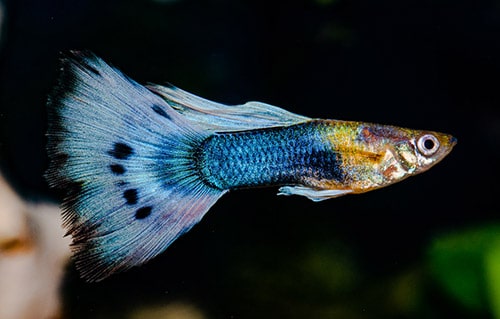
The answer is that it depends on a few factors, including:
- The specific species of guppy
- The quality of care they receive
- Their genetics
In general, however, most guppies will max out at around 2-3 inches in length.
There are some exceptions to this rule, however. For example, the Endler’s guppy is a smaller species of guppy that only grows to be about 1-2 inches in length. And while most guppies are brightly colored, the Endler’s guppy is quite drab in comparison.
If you’re looking for a bigger fish, then you might want to consider one of the other popular freshwater aquarium fish like the goldfish or the betta fish. Both of these fish can grow to be much larger than guppies, but they also require more care and attention.
It’s up to you to decide what size of fish you want in your aquarium. If you have the space and the patience for a larger fish, then go for it! But if you’re looking for a smaller, easier-to-care-for fish, then the guppy is probably the way to go.
How long can a Guppy Fish live without food
While guppy fish can technically survive for a short period without food, it is not recommended to do so as it can lead to serious health problems.
If you must go on vacation or otherwise be away from your fish for more than a week, it is best to find someone who can feed them while you are gone. If they are not fed for two weeks, they will probably die.
Guppy fish are also known to eat other small fishes if they are starving. So, if you have other small fishes in the tank, make sure to remove them before leaving your guppy fish without food.
How to Guppy Fish sleep
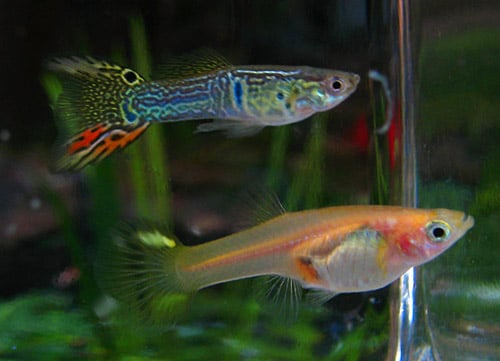
Unlike humans, guppy fish do not have eyelids that close when they sleep. This means that they can be easily awakened by movement or light. Because of this, it’s important to provide your guppy fish with a dark and quiet place to sleep.
Guppies usually sleep at night, but they can also take short naps during the day. When they sleep, their fins and tail will droop down and they will become less active. You may also notice that your guppy’s color will fade slightly when it is sleeping.
If you want to make sure that your guppy is getting enough rest, you can provide it with a dark place to sleep.
You can do this by adding a dark-colored piece of paper or cloth to the bottom of the tank, or by placing a dark-colored object inside the tank. Your guppy will likely find this place more appealing than the bright lights of the aquarium, and it will help your fish get the rest it needs.
You can create a sleeping area for your guppy fish by adding some floating plants or placing a piece of driftwood in the aquarium.
How to choose a Guppy Fish
When it comes to choosing a guppy fish, there are a few things you need to take into consideration.
- First, what is your budget? Guppies can range in price from a couple of dollars to over $100.
- Second, what is the purpose of the guppy? Are you looking for a show fish or one that will do well in a community tank?
- Third, what size tank do you have, and how many other fish will be sharing it with the guppy?
If you’re on a tight budget, consider getting a group of cheaper guppies.
If you want a show fish, look for ones with beautiful tail patterns and bright colors. If you’re planning on keeping the guppy in a community tank, choose a variety known for being peaceful and not overly aggressive.
When it comes to choosing a guppy fish, there are a few things you need to take into consideration.
First and foremost, you need to decide what size of guppy you want. There are three different sizes of guppies – small, medium, and large.
Small guppies are usually around 2 inches in length, while medium and large guppies can grow up to 3-4 inches. Guppies need at least 10 gallons of water to thrive, so ensure your tank is big enough.
Once you’ve decided what type of guppy you want, it’s time to start shopping around. Check pet stores, online retailers, and fish breeders to find the perfect fish for your home aquarium.
When choosing a guppy, be sure to inspect it for any signs of illness or injury. Also, ask the seller about the guppy’s diet and care requirements to ensure that you can provide everything it needs to thrive.
How much does Guppy Fish cost
The average cost of a guppy fish is about $3.50. However, the price may range from $1 to $5, depending on the breeder, store, or supplier. However, prices may vary depending on the specific type of guppy fish you are looking for and the retailer you purchase from.
Some stores or suppliers may charge more for rarer guppy fish.
- For example, you can purchase an albino guppy fish for around $10.
- Meanwhile, a blue guppy fish may cost around $15.
- If you want to purchase a pair of guppy fishes, the price may start at $20.
When purchasing guppy fishes, it is essential to remember that you will also need to buy an aquarium and other supplies to house your new pet.
The cost of an aquarium can range from $50 to $100, depending on the size and type of aquarium you choose.
You will also need to factor in the cost of fish food, which can cost around $10 per month.
In addition, you will need to purchase a filtration system for your aquarium, which can range in price from $30 to $80.
Overall, the cost of owning a guppy fish can range from $100 to $200, depending on the initial purchase price of the fish and the supplies you need to care for them.
How many Guppy Fish are in a tank
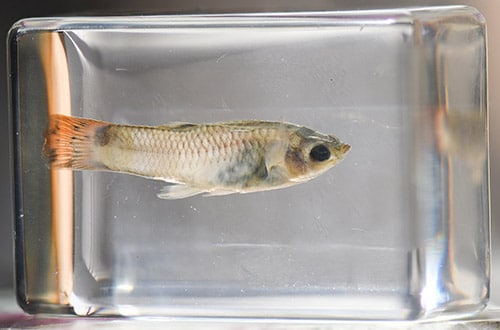
The answer to this question depends on a few factors:
The size of your tank
As a general rule of thumb, you can have 1 guppy per gallon of water. If you have a 10-gallon tank, you could have up to 10 guppies.
However, it’s important to remember that not all tanks are created equal. Some tanks may have more filtration or aeration, so they can support more fish.
If you are still determining how many fish your tank can support, iIt’s much easier to add more fish later on than it is to remove them.
Other fish in your tank
In addition to the size of your tank, you also need to consider the other fish that you have in your tank. If you have other fast-moving or aggressive fish, they may chase and harass the guppies. This can lead to stress and even death.
To avoid this, it’s best to keep guppies with other peaceful fish that are similar in size. Some good choices include mollies, platies, and swordtails.
Your personal preferences
Finally, it’s important to consider your personal preferences when deciding how many guppies to have in your tank. If you want a lot of activity and color, go with a larger number of guppies.
If you prefer a more peaceful aquarium, stick with fewer fish. It’s really up to you and what you think will look best in your tank.
Can Guppy Fish live without a filter?
While some believe that guppy fish can live without a filter, it is generally not recommended.
Guppy fish are notoriously messy eaters and produce a lot of waste. Without a filter, this waste can quickly build up in the tank and lead to poor water quality.
This can cause various health problems for the fish, including infections and diseases.
Additionally, filters help to oxygenate the water, which is essential for all fish. So while guppy fish may be able to survive without a filter, they will likely have a shorter lifespan and be less healthy overall.
Can Guppy Fish live without a pump?
Yes, guppy fish can live without a pump. However, they will not thrive and may eventually die.
A pump is necessary to provide the water movement these fish need to stay healthy. Without a proper water flow, the fish can become stressed, leading to disease. Pumps help circulate the water and keep it clean, so it is still recommended that you use one.
Can Guppy Fish live without a heater?
Guppy fish is a tropical species of freshwater fish that originates from Central and South America.
While guppy fish can technically live without a heater, it is not recommended. This is because guppy fish require water temperatures of at least 75 degrees Fahrenheit to stay healthy.
Without a heater, the water temperature in your aquarium will likely drop too low for your guppies, resulting in health problems. Additionally, guppies are very sensitive to sudden changes in water temperature.
So even if the ambient air temperature in your home is warm enough to keep your aquarium water at a stable temperature, sudden changes can still stress out your fish and make them more susceptible to illness.
For all these reasons, it is best to err on the side of caution and use a heater to maintain a consistent water temperature for your guppy fish. This will ensure that they stay healthy and happy in their new home.
Conclusion
Guppy fish is a great addition to any aquarium. They are relatively easy to care for and can add a splash of color to your tank. These little fish are also fairly hardy, so they can withstand some beginner mistakes.
Now that you know a little bit more about these popular fish, we hope you’ll consider adding them to your aquarium. Guppies are a great way to brighten up your tank and add some personality.
With the right care, they can thrive in almost any environment. Do you have experience keeping guppy fish? We’d love to hear about it in the comments below.

